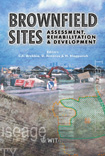Enhanced In Situ Bioremediation Of Chlorinated Solvents
Price
Free (open access)
Transaction
Volume
55
Pages
Published
2002
Size
447 kb
Paper DOI
10.2495/BF020471
Copyright
WIT Press
Author(s)
N. M. Rabah & D. E. Lekmine
Abstract
Anaerobic enhancement of in Situ bioremediation of a shallow, confined, silty sand aquifer has resulted in a substantial biodegradation of a dissolved tetrachloroethene (PCE) plume at an abandoned metal finishing facility located within residential area in northern New Jersey. The injection of a proprietary time-release hydrogen compound rapidly converted ambient aquifer aerobic conditions to anaerobic. This enhancement effectively induced and facilitated the successive reductive dechlorination of PCE and daughter products. Field results confirmed this anaerobic biodegradation enhancement within the overburden aquifer resulted in substantial degradation of PCE and its daughter products in the underlying sandstone bedrock aquifer. The pre-injection dissolved PCE levels of 5 to 8 mg/l at the source declined by 90 to 96% within 2 months of injection. Degradation rates of 96% to 100% were obtained for TCE and t-DCE, whereas the degradation rates of c- DCE were slower and smaller at 30 to 70%. The potential presence of residual product and larger adsorbed solvent mass in the source area resulted in seemingly smaller but faster PCE and TCE overall degradation rates in comparison to downgradient areas. The c-DCE mass degradation during the same period was apparently greater and faster near the source than in the downgradient area. Of interesting significance was the rapid degradation of VC, which was scarcely detected during the monitoring period. Carbon dioxide and methane levels increased by more than 10 fold indicative of VC degradation under both aerobic and anaerobic conditions. Local changes in the REDOX state and in oxygen levels coincided with preferential reduction of competing species (e.g., sulfate), and apparently facilitated the degradation of VC.
Keywords




